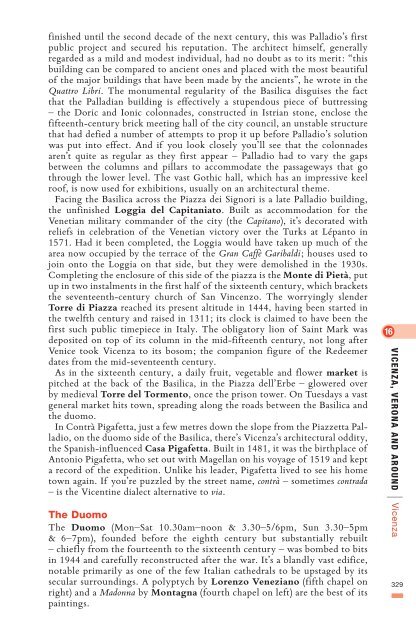Create successful ePaper yourself
Turn your PDF publications into a flip-book with our unique Google optimized e-Paper software.
finished until <strong>the</strong> second decade of <strong>the</strong> next century, this was Palladio’s first<br />
public project <strong>and</strong> secured his reputation. <strong>The</strong> architect himself, generally<br />
regarded as a mild <strong>and</strong> modest individual, had no doubt as <strong>to</strong> its merit: “this<br />
building can be compared <strong>to</strong> ancient ones <strong>and</strong> placed with <strong>the</strong> most beautiful<br />
of <strong>the</strong> major buildings that have been made by <strong>the</strong> ancients”, he wrote in <strong>the</strong><br />
Quattro Libri. <strong>The</strong> monumental regularity of <strong>the</strong> Basilica disguises <strong>the</strong> fact<br />
that <strong>the</strong> Palladian building is effectively a stupendous piece of buttressing<br />
– <strong>the</strong> Doric <strong>and</strong> Ionic colonnades, constructed in Istrian s<strong>to</strong>ne, enclose <strong>the</strong><br />
fifteenth-century brick meeting hall of <strong>the</strong> city council, an unstable structure<br />
that had defied a number of attempts <strong>to</strong> prop it up before Palladio’s solution<br />
was put in<strong>to</strong> effect. And if you look closely you’ll see that <strong>the</strong> colonnades<br />
aren’t quite as regular as <strong>the</strong>y first appear – Palladio had <strong>to</strong> vary <strong>the</strong> gaps<br />
between <strong>the</strong> columns <strong>and</strong> pillars <strong>to</strong> accommodate <strong>the</strong> passageways that go<br />
through <strong>the</strong> lower level. <strong>The</strong> vast Gothic hall, which has an impressive keel<br />
roof, is now used for exhibitions, usually on an architectural <strong>the</strong>me.<br />
Facing <strong>the</strong> Basilica across <strong>the</strong> Piazza dei Signori is a late Palladio building,<br />
<strong>the</strong> unfinished Loggia del Capitania<strong>to</strong>. Built as accommodation for <strong>the</strong><br />
Venetian military comm<strong>and</strong>er of <strong>the</strong> city (<strong>the</strong> Capitano), it’s decorated with<br />
reliefs in celebration of <strong>the</strong> Venetian vic<strong>to</strong>ry over <strong>the</strong> Turks at Lépan<strong>to</strong> in<br />
1571. Had it been completed, <strong>the</strong> Loggia would have taken up much of <strong>the</strong><br />
area now occupied by <strong>the</strong> terrace of <strong>the</strong> Gran Caffè Garibaldi; houses used <strong>to</strong><br />
join on<strong>to</strong> <strong>the</strong> Loggia on that side, but <strong>the</strong>y were demolished in <strong>the</strong> 1930s.<br />
Completing <strong>the</strong> enclosure of this side of <strong>the</strong> piazza is <strong>the</strong> Monte di Pietà, put<br />
up in two instalments in <strong>the</strong> first half of <strong>the</strong> sixteenth century, which brackets<br />
<strong>the</strong> seventeenth-century church of San Vincenzo. <strong>The</strong> worryingly slender<br />
Torre di Piazza reached its present altitude in 1444, having been started in<br />
<strong>the</strong> twelfth century <strong>and</strong> raised in 1311; its clock is claimed <strong>to</strong> have been <strong>the</strong><br />
first such public timepiece in Italy. <strong>The</strong> obliga<strong>to</strong>ry lion of Saint Mark was<br />
deposited on <strong>to</strong>p of its column in <strong>the</strong> mid-fifteenth century, not long after<br />
<strong>Venice</strong> <strong>to</strong>ok Vicenza <strong>to</strong> its bosom; <strong>the</strong> companion figure of <strong>the</strong> Redeemer<br />
dates from <strong>the</strong> mid-seventeenth century.<br />
As in <strong>the</strong> sixteenth century, a daily fruit, vegetable <strong>and</strong> flower market is<br />
pitched at <strong>the</strong> back of <strong>the</strong> Basilica, in <strong>the</strong> Piazza dell’Erbe – glowered over<br />
by medieval Torre del Tormen<strong>to</strong>, once <strong>the</strong> prison <strong>to</strong>wer. On Tuesdays a vast<br />
general market hits <strong>to</strong>wn, spreading along <strong>the</strong> roads between <strong>the</strong> Basilica <strong>and</strong><br />
<strong>the</strong> duomo.<br />
In Contrà Pigafetta, just a few metres down <strong>the</strong> slope from <strong>the</strong> Piazzetta Palladio,<br />
on <strong>the</strong> duomo side of <strong>the</strong> Basilica, <strong>the</strong>re’s Vicenza’s architectural oddity,<br />
<strong>the</strong> Spanish-influenced Casa Pigafetta. Built in 1481, it was <strong>the</strong> birthplace of<br />
An<strong>to</strong>nio Pigafetta, who set out with Magellan on his voyage of 1519 <strong>and</strong> kept<br />
a record of <strong>the</strong> expedition. Unlike his leader, Pigafetta lived <strong>to</strong> see his home<br />
<strong>to</strong>wn again. If you’re puzzled by <strong>the</strong> street name, contrà – sometimes contrada<br />
– is <strong>the</strong> Vicentine dialect alternative <strong>to</strong> via.<br />
<strong>The</strong> Duomo<br />
<strong>The</strong> Duomo (Mon–Sat 10.30am–noon & 3.30–5/6pm, Sun 3.30–5pm<br />
& 6–7pm), founded before <strong>the</strong> eighth century but substantially rebuilt<br />
– chiefly from <strong>the</strong> fourteenth <strong>to</strong> <strong>the</strong> sixteenth century – was bombed <strong>to</strong> bits<br />
in 1944 <strong>and</strong> carefully reconstructed after <strong>the</strong> war. It’s a bl<strong>and</strong>ly vast edifice,<br />
notable primarily as one of <strong>the</strong> few Italian ca<strong>the</strong>drals <strong>to</strong> be upstaged by its<br />
secular surroundings. A polyptych by Lorenzo Veneziano (fifth chapel on<br />
right) <strong>and</strong> a Madonna by Montagna (fourth chapel on left) are <strong>the</strong> best of its<br />
paintings.<br />
Vicenza, Verona <strong>and</strong> around<br />
| Vicenza<br />
329







